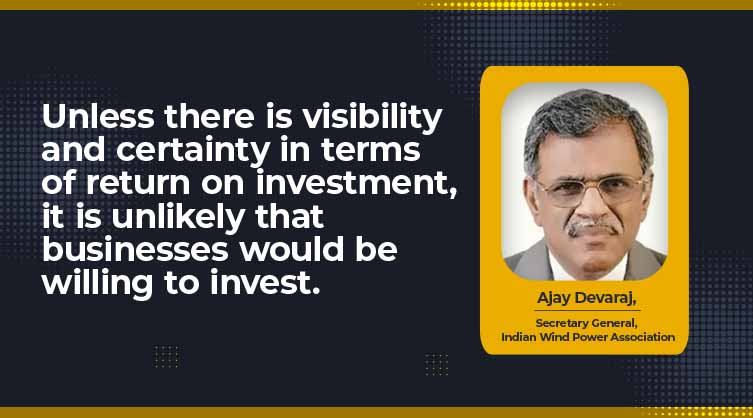To increase investor trust in wind energy, strong policy support is essential
By EPR Magazine Editorial April 26, 2022 3:22 pm IST
By EPR Magazine Editorial April 26, 2022 3:22 pm IST

Ajay Devaraj, Secretary General, Indian Wind Power Association. In an interview with EPR Magazine.
How do you evaluate the potentials for wind energy in India?
India has a huge yet largely untapped potential for wind energy. Out of a total potential of around 695 GW, 666 GW of windy sites are still unexploited. In addition, considerable potential also lies offshore.
How do you look at the wind turbine manufacturing and demand supply scenario in India?
Currently, only around 10 percent of wind turbine manufacturing capacity is being utilised. This is because the market for turbines comes solely from SECI and similar auctions.
What are the major challenges faced by the industry on installation of windfarms?
Some of the major challenges include, post installation, pertain to Right of Way (ROW); availability and adequacy of transmission network; poorly maintained pooling substations; curtailment; charges levied by DISCOMs that are enhanced regularly, while WEGs remain bound by a PPA with a tariff fixed for 20/25 years; delayed payments by DISCOMs; annual escalations for AMC / O&M, and many more.
What are the latest trends in technologies and design of wind turbines? How do you observe the acceptance of new technologies in the country?
The trend seems towards “the bigger/taller the better”. There are substantial enhancements in the size and capacities. In addition, there are also significant increases in hub heights. There do not appear to be any problems regarding acceptance by investors.
Several wind energy generating companies have adopted Artificial Intelligence and Machine Learning models. In fact, they have adopted these technologies even in respect of older generation machines. They also use drones and crane-less technologies for operation and maintenance.
The reluctance, however, is in re-powering of older machines. This is more because of poorly crafted laws on the subject and the Regulators failing to respond to entreaties by the industry for policies and laws that are grounded in reality. The current laws make it economically non-viable to undertake repowering.
What are the bottlenecks that retard the pace of growth in India for windpower?
There are several bottlenecks that retard the pace of growth:What are the steps needed from a policy front to iron out these challenges?
It is five years since India moved from the cost-plus to the reverse auction system. Accordingly, there is adequate data now available to make informed decisions. The Policy makers would do well to examine ground level data and to determine what needs to change for the nation to achieve a growth in the installed capacity of wind energy @ 17.5 GW every year from 2022 till 2030. Only then will the target of 140 GW by 2030 from wind be achieved. It would not be out of place to mention that post adoption of the reverse auction system, there is also a reversal in the growth of annual installed capacity.
Strong policy support is required to bring in investment in the sub-50 MW market. Rather than seeking to achieve system stability by burdening RE Generators with an additional financial burden on account of Forecasting, Scheduling and Deviation Settlement Mechanism penalties, it would be better to promote technologies that actually promote grid stability.
Transparency and visibility in the implementation of current regulations, both at central and state levels, is required in order to build investor confidence. Unless there is visibility and certainty in terms of return on investment, it is unlikely that businesses would be willing to invest.
With renewable power gaining traction in the country, what are the opportunities you observe for wind power in the country?
In terms of the sheer potential still remaining untapped, the opportunity is immense. Approximately 10 percent of the untapped windy sites have a CUF of +35 percent. This is far higher than the CUF available from other RE sources.
Rather than promoting pure wind or pure solar, it would make a lot more sense to promote hybrids. Pure wind would have an average CUF of 25-30 percent; similarly, pure solar would have an average CUF of 15-20 percent. However, if combined, the CUF can go up as high as 50-60 percent. Further, the storage configuration required in order to deal with their variability also comes down, thereby significantly reducing storage costs. Yet another advantage is greater productive use of the transmission network.
We have already expressed our views to EPR on offshore wind earlier where we talked about the concept of Power to X. In addition to that, there are two more advantages – (i) as against availability of wind for around 150 days in a year for onshore wind installations, in respect of offshore it doubles to around 300 days in a year. (ii) Co-location of ‘X’ eliminates transmission losses which average around 23 percent currently. Quite clearly, therefore, there are several economic advantages in respect of offshore wind.
We use cookies to personalize your experience. By continuing to visit this website you agree to our Terms & Conditions, Privacy Policy and Cookie Policy.